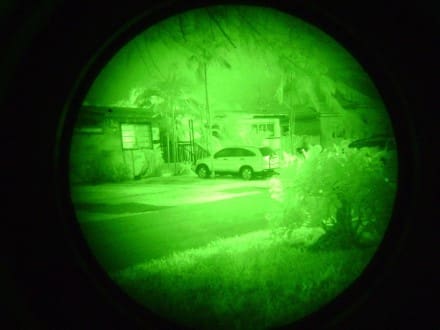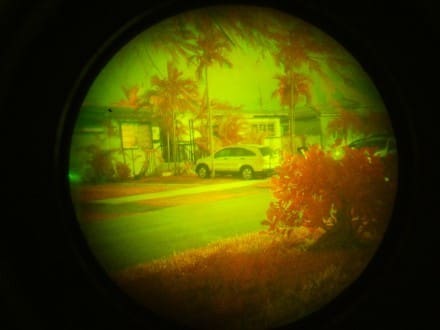Here are two pictures taken through night vision on a moonless cloudy night. The one on the left is regular night vision. The one on the right is through Adams Industries HDNVG.
In normal night vision you can see that there’s a car parked in the driveway.
With HDNVG you see:
• Some of the areas you thought were street are actually grass.
• There is a tree behind the car that could provide concealment.
• There is a power pole behind the house.
Oh, and the car’s not parked in a driveway; it’s parked on the grass
Coming to SHOT Show.
Tags: Adams Industries




This stuff can make some kind of revolution just like “color” X-ray scanners did in screening.
The technology should be based on wavelength/energy selection, red tint represents 800…1500nm near-infrared, I suppose… So it should even help to detect, for example, fresh branches or grass, cut for camouflaging something – it should be visibly less red-tinted.
The night the picture was taken there was a half moon and a it was overcast. This made for an IR rich environment. Remember, we are NOT pushing this as “color night vision” only “High Definition” so though you brain may scream “trees are not red!” for the first minute or so, you get used to it. We could color correct the bushes back to green, but then we’d be throwing away a LOT of light.
Of course, it’s your business strategy to call it whatever you like (“HD” instead of “color”) and I understand, why – people could easily read the “color night vision” like “night vision that shows real colors”, and that’s not true, of course. While “high definition” sounds true, because human eye is able to detect color difference better than intensity difference (at least if the picture is bright enough), that’s why, for example, thermal vision devices using “ironbow” LUT. As well as “color” X-ray does not show the actual colors of stuff in your bag, but using colors to represent different materials (plastic, metal).
I have some long experience in satellite imagery processing, and it’s OK for me to see the red vegetation, that’s why I’m so excited about that.
So called “multispectral false-color composites” made of different visible and IR wavelengths are one of the most powerful tool of remote sensing, because it usually lets you to see much thinner details than so called “panchromatic” images.
By the way, you can use it for advertising – something like “NASA used it for decades, now you also can”.
We had thought to call it “high contrast” but HDNVG sounds way cooler than HCNVG. I admit it, marketing got the better of me.
Yes, “HCN” in the beginning refers to Hydrogen cyanide, that is not so cool.
It also means Host Country National
Yes, and Google says it’s repeated just 20% less times than hydrogen cyanide on the Internet. 🙂
Night vision stagnated for quite awhile but this looks to be a huge leap forward.
Chris, I have to say this is much better than I expected. To say the very least this is a complete game changer for any profession that needs the use of night vision. I can not wait to try this our on my Sentinel’s. This is amazing. This will be especially helpful for patrols in vegetated areas and from aircraft. Thanks for this Chris.
Can be used with a TACS-M?
Actually yes it can.
I’m going to need a lot of DSP-83 forms…
That I can provide! 😉
Can you pass me a contact email? Thanks
Just come through the main email sales at adamsindustries dot com and I’ll pick you up there.
Wow! Looks like a real breakthrough! Hopefully we will get these at the day job but Im not holding my breath. Stay safe! And a big thanks to Adams Industries for investing in the technology toake MIL/LE jobs safer!
Hey Will,
We will be offering these in kits where you can use your existing binocular goggles or two monoculars. Hopefully that will keep us from breaking the bank.
Chris,
That sounds great! And thanks for the quote a while back. Les sent it to me and I still need to get back to him.
This looks a lot like color IR photography. Very cool to see this used with NODs. It surprises me that this hasn’t been done untll now.
Hey Woody,
It has in some other layouts but they never seemed to get traction due to costs and ruggedness issues. We’re hoping to change that reality.
Wow, just about sums it up.
Thank you Sir!
And don’t forget folks to come by booth 6409. We’ll be holding a raffle for a limited edition knife at the end of the how (thats how we plan to con you into giving us your business card).
To clarify, can this be used on a single monocular, or does it require dual tubes/paired monoculars?
Can we get a hint on cost?
Must be dual. You can use your existing binocular goggle or two monoculars with a bridge.
It’s gonna be less than a grand MSRP. There’s one filter that is more than the rest combined in small quantities and that’s where we need to get some volume before the price will come down and even then it’ll be incrementally.
hold the phone there, less than a grand? is that per tube or for a functioning binocular unit? I’d hope the latter but the realistic side of my brain is saying the former!
Or am I missing the point entirely and this is a cool but expensive upgrade for existing Gen3 nods?
Cool upgrade. Expensive is a matter of opinion.
So, these are just tube upgrades that can be integrated into head mounted NOD’s?
Has there been any official government testing by PEO Soldier, NAVSEA, PEO SOF, AFMC, MCSC etc?
Has there been any thought put into “fusing” this technology with emerging capabilities like thermal and making it sensitive SWIR in the event it replaces IR illumination for small arms targeting?
There has been mucho testing by all sorts of people and currently there are units in service.
Right now we’re just trying to get the first steps going. We’ll get all wild with the SWIR once we can make a couple bucks. Gotta pay the rent first!
Clarify the”whom” in regards to “mucho testing” are “in service with” in your response please.
Umm.. NO. You don’t have a need to know that. Sorry.
Is this upgrade approved by the FAA?
No, this can’t be used with any goggle with minus B filters so that pretty much kills ANVIS. However we are working on a 3D kit for ANVIS goggles to greatly improve depth perception (and yes I know all the arguments about whether or not you can get depth perception with any kind of optic. Call it “perceived depth perception” if it makes you sleep better).